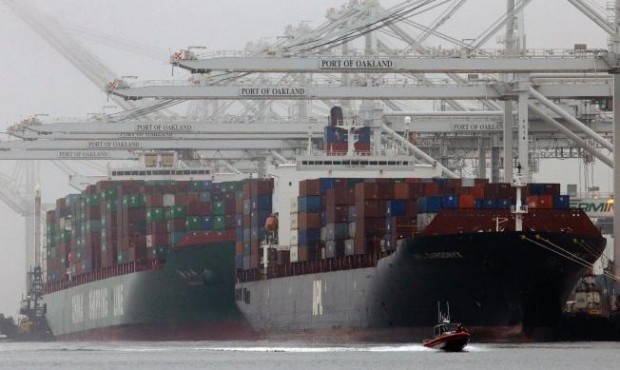America to Step off World’s Best Economy Ranking

US News
The U.S. is expected to retain its status as the world’s largest economy for a few years longer than analysts previously anticipated, thanks in large part to China’s recent financial slowdown, according to a recent study from the U.K.-based Centre for Economics and Business Research.
But over the course of the next 16 years, the global economic landscape is expected to shift seismically from where it now stands. Though the U.S. is still expected to hold a spot among the exclusive G-8 collection featuring some of the world’s largest economies by the year 2031, a handful of other current members are likely to be less fortunate.
In 2031, China will be the largest economy in the world with a gross domestic product valued at $35.26 trillion, according to the CEBR. The U.S. will play second fiddle to the Asian behemoth, with GDP clocking in at $33.66 trillion.
The two world powers are expected to swap places in 2029, which gives the U.S. a little more time on top than the economic consultancy previously projected. Last year, the CEBR predicted the switch would take place in 2025. It attributed “slower Chinese GDP growth and a weaker currency” to the timing adjustment.
Below are the CEBR’s projections for the world’s largest economies in 16 years, compared with how things stand now:
World’s Largest Economies, 2015
- United States
- China
- Japan
- Germany
- United Kingdom
- France
- India
- Italy
- Brazil
- Canada
- South Korea
- Saudi Arabia
- Australia
- Russia
- Spain
World’s Largest Economies, 2031
- China
- United States
- India
- Japan
- Germany
- United Kingdom
- South Korea
- Brazil
- France
- Canada
- Indonesia
- Mexico
- Italy
- Russia
- Australia
By some measures, China is already considered the world’s largest economy. According to a report released last year by the International Monetary Fund that compared international economies by adjusting for exchange rates and purchasing power, China’s economy had already surpassed America’s as the world’s largest.
But most analysts don’t consider that purchasing power metric to be a primary measuring stick. The U.S. is still generally hailed as the world’s largest economy and is likely to retain that title for at least the next decade.
“No doubt, [China’s] GDP is worse than that 6 or 7 percent that they report,” says John Canally, a senior vice president and chief economic strategist at LPL Financial. “No doubt they’ll lower that target next year, but there’s also no doubt that they’ll pull out all the stops to make sure that the Chinese economy at least stabilizes next year.”
China and the U.S. are hardly the only nations whose economic standing is expected to shift by 2031, according to the CEBR. France and Italy are expected to lose their places among the eight largest economies in the world, to be replaced by South Korea and Brazil. And that could mean major shake-ups in trade groups and economic organizations are right around the corner.
“Some of the weaker European economies like France and Italy are slipping way down the table. They face exclusion from bodies like the G-8 and possibly eventually the G-20 as their economies persistently underperform,” a statement accompanying the report said. “International bodies are likely to have to change their membership to reflect the changing balance of economic power.”
The internationally influential G-8 group of major world economies (which has consisted of the U.S., Germany, Russia, France, Italy, Japan, the U.K. and Canada, though Russia was suspended from inclusion last year over its actions in Crimea) already isn’t organized based solely on GDP value. China and India, for instance, are absent from the group and countries like Canada and Russia – neither of which cracks the world’s top eight in terms of GDP – are or were previously included.
So it is likely that at least some adjustment will take place in the G-8 and organizations similar to it going forward. Adding weight to that projection, the CEBR said the world’s slowest-growing region over the next decade and a half will be Western Europe, with its share of the global economy falling by more than 40 percent by 2031.
The 19-country eurozone’s collective GDP has expanded by an average of only 0.2 percent per quarter since 2010. For comparison’s sake, the U.S. has maintained an average of more than 2.1 percent over the same window.
“Although France continues militarily to punch above its weight, replacing the U.K. as the U.S.’s leading military partner in the Middle East, economically the picture is dire,” the report said. “France is forecast to slip from being the fifth-largest world economy in 2013 to the ninth-largest by 2031, leading it no longer to qualify on economic grounds for membership of the G-8 largest economies.”
The United Arab Emirates, meanwhile, is expected to crack the Top 30 largest economies for the first time by 2031, while Asian nations like Malaysia and the Philippines also are projected to make their way onto the list. Indonesia is expected to jump from the 17th slot to the 11th.
But perhaps the biggest mover is India, an economy that ranked as only the ninth largest in 2014. The country will move up to No. 3 by 2031, according to the CEBR, and has already eclipsed China in terms of annual growth. India is currently the sole bright spot among the emerging market growth engines known as theBRICS nations (which also include Brazil, Russia, China and South Africa), and the World Bank projects the country’s expected 7.5 percent GDP growth in 2015 (which will inflate up to 8 percent by 2017) will outpace most other major world economies.
“The world’s most populous nation has made a start in 2015 in catching up with China, with faster economic growth than China for the first time in years,” the CEBR report said. “But there is still a long way to go, and India is only likely to overtake China at some point in the second half of the 21st century.”
Indeed, it’s worth noting that India’s GDP is expected to be valued at $10.63 trillion in 2031. That’s still smaller than the current sizes of both the Chinese and American economies, and it will be less than a third the size of either in 2031. So although the U.S. is expected to fall to No. 2, it’s unlikely any nation other than China and maybe India will catch the country in the foreseeable future.
And considering the populations of both China and India dwarf that of the U.S., that’s not entirely surprising.
“The United States remains the most successful of the world’s older economies and the world’s technological leader,” the report said. “Indeed, as software becomes the world’s key industry, the U.S.’s position as a technology leader is reinforced.”
How to submit an Op-Ed: Libyan Express accepts opinion articles on a wide range of topics. Submissions may be sent to oped@libyanexpress.com. Please include ‘Op-Ed’ in the subject line.
- Libya’s HCS invites applicants for key state roles - December 31, 2023
- UK calls on Iran to prevent escalation in Israel-Hamas conflict - November 05, 2023
- Libyan Interior Minister: Immigrant shelter costs a fortune - November 05, 2023


